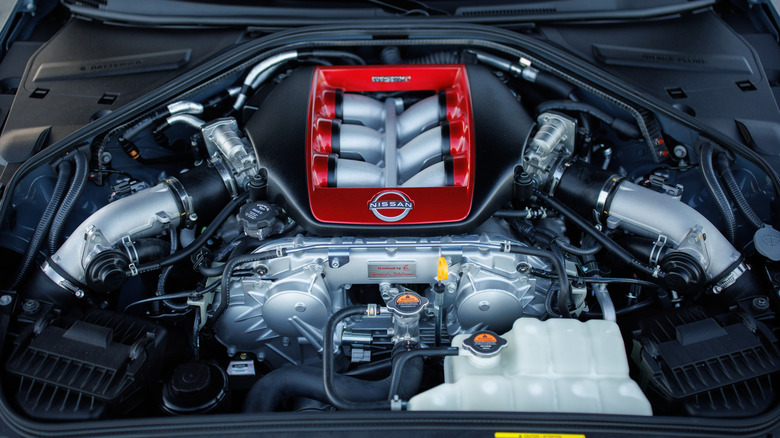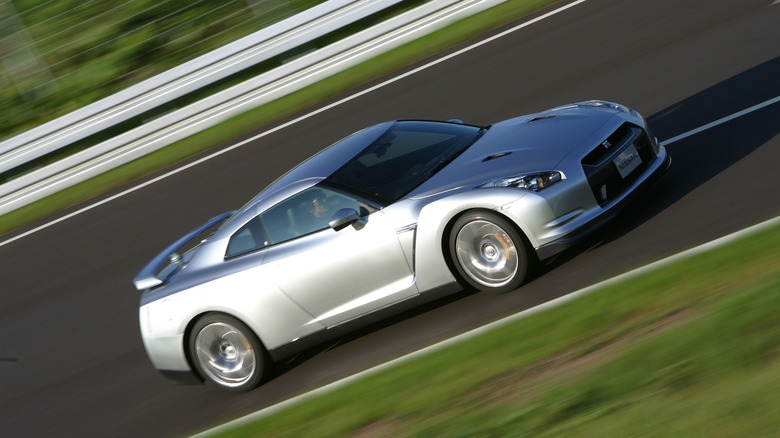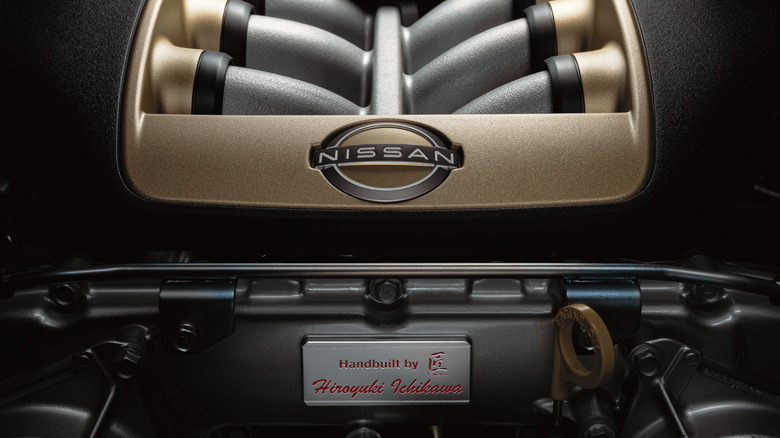How Much HP Does A Nissan VR38 Engine Produce And What Makes It So Special?
It's 15 years old and powered the R35 Nissan GT-R since its launch back in 2009, but the VR38DETT is still a pretty special engine. It's called the VR38 for short, but the engine that powers the Nissan GT-R is a 3.8-liter twin-turbocharged V6. Back in 2009, it was making 480 hp and 430 lb-ft of torque — big numbers for the time and still respectable by today's standards. But Nissan has added power over the years to help keep the GT-R competitive, with 2024 models making as much as 565 horsepower and 467 lb-ft of torque with standard GT-Rs and 600 horsepower coming from limited-availability Nismo models.
So what makes the VR38 engine so special? For starters, it's hand-built, a rare distinction among production-car engines. A unique team of master craftsmen known as the Takumi put together the engines for the Nissan GT-R and Super GT300 racing versions of the same engine. There are special building techniques required for the VR38 and when each engine is finished, special touches are applied, setting the VR38 apart from standard production engines. More than just powerful, the Nissan GT-R's powertrain is treated with a particular kind of respect and reverence — an appropriate homage considering the GT-R's illustrious past.
Arrival of the VR38 engine in the R35 GT-R
Every R35 GT-R came standard with the VR38 from the beginning. There were no other engine options along the way and no other production car has used the VR38 since (with the exception of the wacky one-off concept known as the Juke-R). On top of being hand built, VR38 engines are made in a special clean-room environment at Nissan's Yokohama engine plant. There, the aforementioned master craftsmen known as the Takumi (named after builder Takumi Kurosawa) hand-measure things like valve clearance, adjusting each engine until it is ready to leave the factory. The engine itself was built with cutting edge techniques like plasma-sprayed bores that reduced internal friction, and enhanced cooling.
The Nissan GT-R has roots going all the way back to the 1950s, but it didn't arrive in the United States with its special VR38 engine until late 2008 (as a 2009 model). Nissan wanted to be sure that GT-R owners were given a special ownership experience, so when it did arrive, Nissan dealers who wanted to sell GT-Rs had to get special "GT-R Certification" from HQ. That certification included, among other things, the requirement to staff a master technician for GT-R service and special training for service managers.
How much power can a VR38 make?
Early GT-R models were rated at 480 hp and 430 lb-ft of torque, and paired with Nissan's ATTESA E-TS all-wheel drive. That meant the GT-R could sprint from zero to 60 mph in just 3.3 seconds, according to Car and Driver testing. It's a time that's still impressive fifteen years later. The power numbers, however, went up quickly from there. By 2012, Nissan had decided to increase power by increasing boost pressure from the turbochargers, tuning the valve timing and air/fuel ratio, and making the intake a bit bigger. The result? 530 hp and 448 lb-ft of torque and a significantly decreased zero-to-60 time of 2.9 seconds – on pace with some of today's fastest sports cars.
In 2013, Nissan upped the power again, this time to 545 horses and 463 lb-ft. Numbers crept up even further to eventually reach a peak of 600 hp and 481 lb-ft with 2024 GT-R Nismo models, but even that number seems pedestrian in comparison to highly-tuned versions of the VR38. Internet forums are full of passionate arguments about how much power VR38s can make with some simple tuning changes, as well as a number of claims of four-digit power being available via some relatively simple modifications – and it's hard to put much stock in those claims. But when you see vehicles like the Formula Drift "Altimaniac" being powered by a VR38 that puts out a whopping 2,000 hp, previously preposterous claims seem a bit more believable.
Paying homage to the special engine builders behind the VR38DETT
The final version of the already-special R35 is a tribute to the long-running VR38-powered GT-R, saying goodbye to the nameplate in style. The two final editions of the R35 GT-R are titled T-spec Takumi and Skyline and they're limited to 200 units. The Skyline is painted Bayside Blue, one of the most iconic colors in GT-R history and the T-spec Takumi pays tribute to the engine builders who put together every GT-R engine by hand.
The Skyline is certainly desirable, but the T-Spec Takumi gets unique touches like a gold VIN plate in the engine bay, red-etched writing on the engine itself, and a midnight-purple paint job – giving it its own special appeal. Regardless of model year, the GT-Rs VR38 is clearly special and deserving of the tribute. From its refined production process to its insane horsepower output potential, this twin-turbo V6 will definitely be remembered fondly in the Nissan history books.



